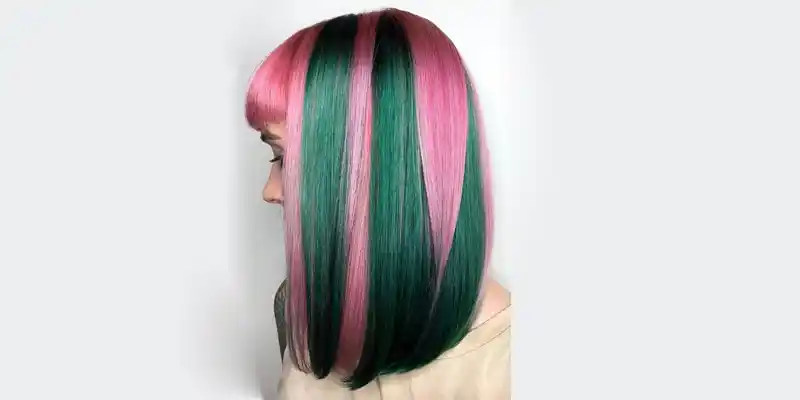Ever wondered what happens when you mix pink and green hair dye? It’s a question that pops up more often than you’d think, especially for those of us who love experimenting with bold, vibrant colors. Mixing hair dyes can be a fun way to create unique shades, but not all color combinations yield the results you might expect.
When you combine pink and green, you might be hoping for a magical new hue, but the reality is a bit different. These two colors often mix to create a brown or muddy tone. Understanding why this happens can save you from a hair color disaster and help you make better choices for your next dye job.
Understanding Pink And Green Hair Dye
Mixing pink and green hair dye typically results in a brown or muddy color. This outcome is grounded in essential color theory and the science behind hair dyes.
Color Theory Basics
Color theory explains that combining complementary colors like pink and green results in neutral hues. Pink, a tint of red, pairs with green, and their mix produces brown or muddy shades. This interaction occurs because complementary colors on the color wheel cancel each other out. Understanding this principle assists in predicting outcomes before dye application. For instance, blending other complementary colors, such as blue and orange, yields similar neutral results.
The Science Of Hair Dye
Hair dye chemistry plays a crucial role in mixing outcomes. Hair dyes contain pigments that deposit color onto hair shafts. When applied, the base color and hair’s natural pigment interact with dye molecules. Pink and green dyes, when mixed, form chemical reactions leading to brown or muddy tones due to their complementary natures. Knowing the dye’s composition, including developer and pigment type, aids in anticipating results. Artificial dye molecules combine in complex ways, and this particular mix results in undesirable hues, reflecting deeper scientific principles in hair coloring.
Mixing Pink And Green Hair Dye
Mixing pink and green hair dye often results in shades of brown or muddy colors. This outcome stems from the principles of color theory.
Expected Outcome
Combining complementary colors like pink and green neutralizes them, leading to a brown or muddy result. Hair dye compositions amplify this effect, as they contain different pigments that react chemically. Mixing these dyes creates a less vibrant shade.
Factors That Affect The Result
-Dye Quality: Higher-quality dyes may produce a clearer shade, while lower-quality ones often result in muddy colors.
-Hair Porosity: Highly porous hair absorbs and mixes dyes differently, potentially yielding unpredictable colors.
-Proportions: The ratio of pink to green dye affects the resultant shade. Equal parts generally produce a brown color, while varying proportions may lead to slight color shifts.
Real-World Examples
Observing how pink and green hair dye mixes can provide practical insights. Looking at high-profile transformations and common mistakes can help anticipate results.
Celebrity Hair Transformations
Celebrities often experiment with bold hair colors, offering a glimpse into mixing outcomes. For example, when Billie Eilish mixed green with another color, the result was a brownish shade. This showcases the neutralizing effect and helps understand the final color. Paying attention to these examples can guide individual hair color choices.
Common Mistakes And How To Avoid Them
One common mistake is not considering the base color. If hair is already a mix of colors, adding pink and green can turn muddy. Testing dyes on small sections helps avoid unexpected results. Another mistake involves incorrect dye ratios. Equal parts pink and green typically make brown; adjusting ratios might achieve less neutral tones. Proper preparation and following these tips can prevent undesirable outcomes.
Tips For Achieving Desired Results
Combining pink and green hair dye often leads to brown or muddy colors. Understanding key factors helps achieve better results.
Choosing The Right Shade
Select high-quality dyes for better results. Cheaper options often contain inconsistent pigments, leading to unexpected colors. Opt for professional-grade products. The base color of your hair influences the final shade. For example, if your hair is very light, the mixed dye may look darker than if your hair is a medium brown. Always consider the underlying tones in your hair before mixing dyes.
Professional Vs. DIY
Professional stylists possess the expertise to mix colors effectively. They can measure precise ratios and cater to your hair’s specific needs. If you go the DIY route, some factors need to be managed. Use a strand test to ensure the desired outcome. Follow the dye manufacturer’s guidelines carefully. Experienced DIYers can experiment more, but always keep in mind that unexpected results can occur without professional oversight.
Conclusion
Mixing pink and green hair dye can be a tricky endeavor often leading to brown or muddy results. Understanding color theory and the factors influencing the final shade is crucial. From dye quality to hair porosity every detail matters. Real-world examples like Billie Eilish’s hair transformations highlight how these colors can neutralize each other.
To achieve the best results consider your base hair color and always test small sections first. High-quality dyes and professional advice can make a significant difference. For DIY enthusiasts strand tests and adhering to manufacturer guidelines are essential to avoid any unwanted surprises.
